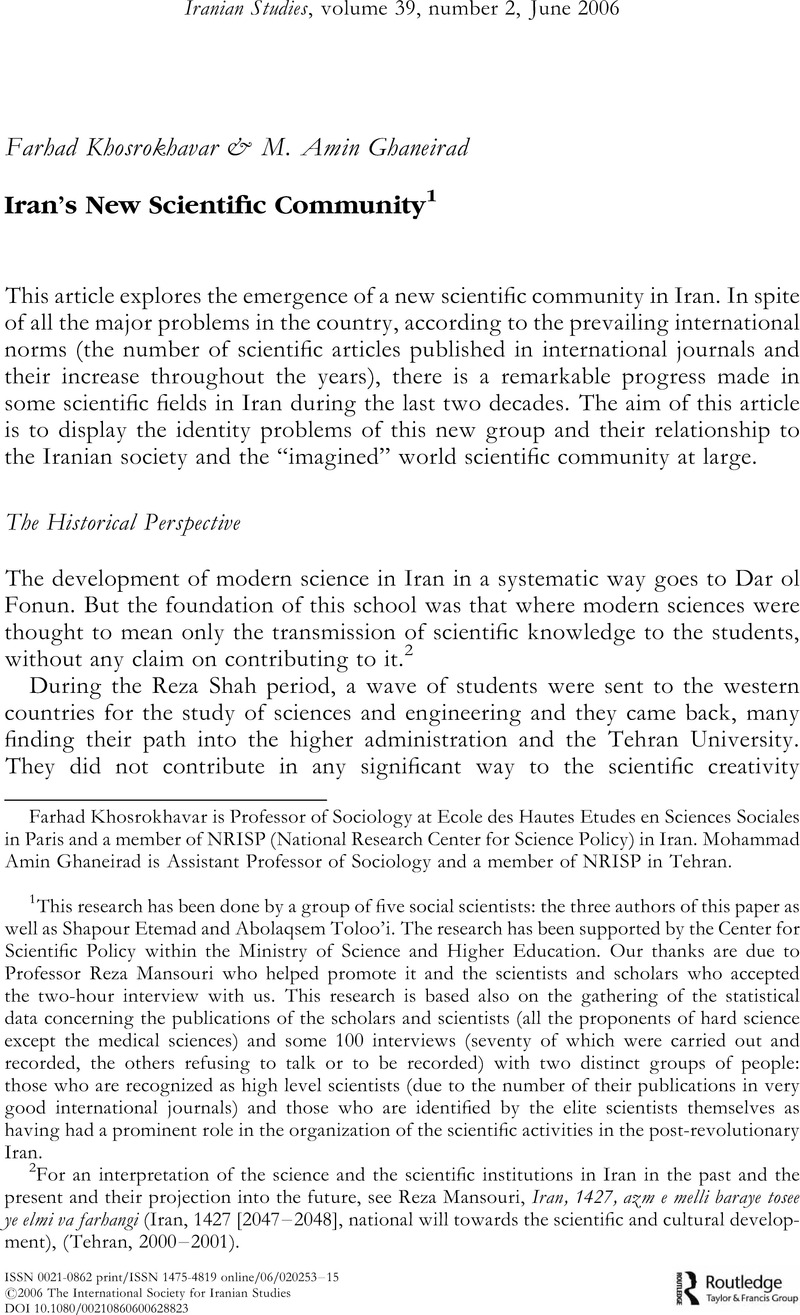Article contents
Iran's New Scientific Community
Published online by Cambridge University Press: 01 January 2022
Abstract

- Type
- Articles
- Information
- Copyright
- Copyright © 2006 The International Society for Iranian Studies
References
1 This research has been done by a group of five social scientists: the three authors of this paper as well as Shapour Etemad and Abolaqsem Toloo'i. The research has been supported by the Center for Scientific Policy within the Ministry of Science and Higher Education. Our thanks are due to Professor Reza Mansouri who helped promote it and the scientists and scholars who accepted the two-hour interview with us. This research is based also on the gathering of the statistical data concerning the publications of the scholars and scientists (all the proponents of hard science except the medical sciences) and some 100 interviews (seventy of which were carried out and recorded, the others refusing to talk or to be recorded) with two distinct groups of people: those who are recognized as high level scientists (due to the number of their publications in very good international journals) and those who are identified by the elite scientists themselves as having had a prominent role in the organization of the scientific activities in the post-revolutionary Iran.
2 For an interpretation of the science and the scientific institutions in Iran in the past and the present and their projection into the future, see Mansouri, Reza, Iran, 1427, azm e melli baraye tosee ye elmi va farhangi (Iran, 1427 [2047–2048], national will towards the scientific and cultural development), (Tehran, 2000–2001)Google Scholar.
3 See Thirty Years of International Scientific Production in Iran (si sal towlid jahani elm iran), Shapour Etemad, Yahya Emami, Masoud Mehrabi, National Research Institute for Science Policy, (Tehran, 2004).
4 For the study of a newborn university and its disorganization throughout the first years of the Revolution, see: Farhad Khosrokhavar, “Crise de l'université dans la révolution iranienne.” Peuples Méditerranéens, Mediterranean Peoples, n.13, 1980, 65–88.
5 See Thirty Years of International Scientific Production in Iran, op.cit; Sh. E'temad, A Heydari, M. Sarbloki, M. Mehrdad, Tahqiqat va arzyabi e an: pajooheshgah e danesh ha ye bonyadi (Research and Its Evaluation: The Institute for Theoretical Physics and Mathematics), Akhbar, 9 no. 1, (spring 1381/2002–2003), Tehran; Mas'oud Mehrabi, Moassessat e pajouheshi e keshvar (The Research Institutions of the Country [Iran]), (1379/2000–2001), Ministry of Sciences and Technology, (1379), Tehran.
6 For a theoretical and historical framework, see Katouzian, Homa, The Political Economy of Modern Iran, (London and New York, 1981)CrossRefGoogle Scholar.
7 For an account on a university in western Iran during the Islamic Revolution, see Khosrokhavar, Farhad, “Le Crise de l'université dans la révolution iranienne,” Peuples Méditerraneans/Mediterranean Peoples, 13, (1980): 3–30Google Scholar; and idem, “Ci-devants techoncrates,”Peuples Méditerraneans/Mediterranean Peoples, 29 (1984): 105–116. For a more general account, see idem, L'anthropologie de la révolution iranienne (Paris: 1987).
8 For a more extensive account, see Farhad Khosrokhavar, Shapour Etemad, Masoud Mehrabi, “Report on Science in Post-revolutionary Iran—Part One: Emergence of a Scientific Community?” Critique, 13, no. 2, (Spring 2004): 209–224; Khosrokhavar, Farhad, Etemad, Shapour, Mehrabi, Masoud, “Report on Science in Post-Revolutionary Iran—Part II: The Scientific Community's Problems of Identity,” Critique, 13, no. 3 (Fall 2004), 363–382Google Scholar.
- 2
- Cited by


